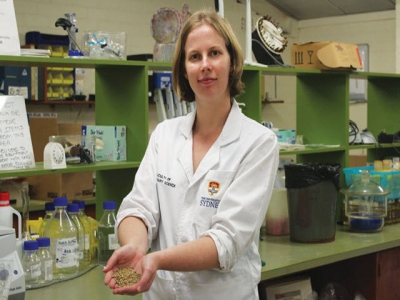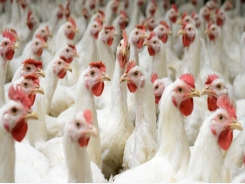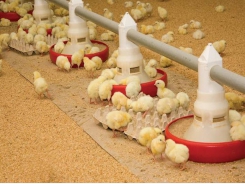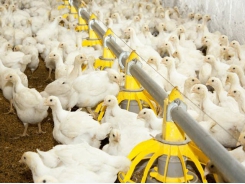Whole grains in broiler diets may boost feed efficiency

Including whole grains in chicken diets boosts growth and may cut feed costs.
Studies on including whole grains in broiler diets, carried out by Amy Moss at the University of Sydney, have found that feed conversion rate increases while feed costs go down. | Jesse Wooldridge
Including whole grains in broiler diets can increase the efficiency of meat production and offer feed cost savings, work at the University of Sydney, Australia, has shown.
Research by Amy Moss, PhD student at the university’s Poultry Research Foundation, has found that replacing some of the ground grains in chickens’ feed with whole grains not only improves digestion, but also influences how efficiently birds convert feed into meat.
Moss’ studies have found that whole grain feeding naturally enhance birds’ innate capacity to digest. While pellets may be appetizing to chickens, they break up very easily once ingested, and this provides very little stimulation for the gizzard. This lack of stimulation leads to less gastric stimulation and poorer digestion, ultimately reducing the amount of meat produced per kilo of feed consumed.
But a stimulated, more muscular gizzard not only grinds down the whole grains; it also stimulates the production of more gastric solutions, so making better use of the feed.
The study has found that, by replacing about 30 percent of ground grain with whole grains, chickens produced 7.7 percent more meat per kilo of feed eaten. Additionally, the cost of feed is lowered.
How grains are added to feed also has an impact on production efficiency.
Whole wheat can be added to poultry diets in two ways: after pelleting as a separate entity to the pellet (post-pellet whole grain feeding), or it can be incorporated during pelleting (pre-pellet whole grain feeding), and each method would appear to have its own benefits and drawbacks.
Post-pellet whole grain feeding results in the greatest gizzard response, both in terms of gizzard size and efficiency. However, this method requires an adaptation period, so chickens do not refuse the whole grains and flick them out of the feeder.
With pre-pellet whole grains, no adaption period is needed as birds only see the pellets, however, this approach generally elicits a poorer response in gizzard size and efficiency.
Additionally, when pellets are cut during the pelleting process, it slightly damages the pre-pellet whole grains, but the benefit is that they can be more easily consumed by small chicks, which can be an issue with post-pellet whole grains.
Moss said: “We traditionally feed poultry pellets of finely ground ingredients. Chickens fed these diets don’t use their gizzards so these organs get very flabby. If you add more whole grains to chickens’ diets, their gizzards get a workout, and just like us when we get a work out, the gizzard gets more muscle.
“The beauty of whole grain feeding is that it improves efficiency of production without using any additional resources or fancy equipment; simply changing the way the grain is fed to enhance the efficiency of chicken meat production.”
Benefits of choice
However, where post-pellet feeding is concerned, it may not simply be stronger gizzards that are influencing performance.
Moss’ studies have included offering pelleted feed and whole grains in separate feeders, giving birds the opportunity to choose between the “low-protein” whole grains and the “high-protein” concentrated ration.
Birds offered 30 percent post-pellet whole grains exhibited the strongest preference for a high-protein diet, consuming proportionately more pelleted concentrate than when lower percentages of whole grains were offered. This opportunity to choice feed and the selection of higher-protein dietary intakes contributed to enhanced performance under whole grain feeding regimes.
This echoed previous work which found that, via choice feeding, birds will select for their own nutritional needs.
To date, studies have concentrated on broilers, however, similar results are expected to be found in layers.
Moss presented her findings at the 29th Australian Poultry Science Forum in February. The next phase of her studies will be to develop and test a combined approach which utilizes pre- and post-pellet whole grain inclusion to tailor the whole grain feeding regime to the development of the growing broiler chick.
Related news
Tools

Phối trộn thức ăn chăn nuôi

Pha dung dịch thủy canh

Định mức cho tôm ăn

Phối trộn phân bón NPK

Xác định tỷ lệ tôm sống

Chuyển đổi đơn vị phân bón

Xác định công suất sục khí

Chuyển đổi đơn vị tôm

Tính diện tích nhà kính

Tính thể tích ao



 Are broiler feed prestarters worth the cost?
Are broiler feed prestarters worth the cost?  Using classic poultry nutrition against coccidiosis
Using classic poultry nutrition against coccidiosis